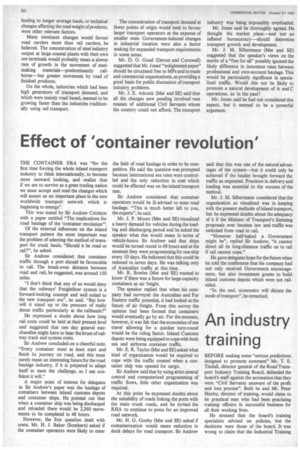Effect of 'container revolution'
Page 52

If you've noticed an error in this article please click here to report it so we can fix it.
THE CONTAINER ERA was "for the first time forcing the whole inland transport industry to think internationally, to become more outward looking, and realize that if we are to survive as a great trading nation we must accept and read the changes which will assure us an important place in the new worldwide transport network which is beginning to emerge".
This was stated by Sir Andrew Crichton with a paper entitled "The implications for road haulage of the 'container revolution".
Of the external influences on the inland transport pattern the most important was the problem of selecting the method of transport for trunk hauls. "Should it be road or rail?", he asked.
Sir Andrew considered that container traffic through a port should be favourable to rail. The break-even distance between road and rail, he suggested, was around 150 "I don't think that any of us would deny that the railways' Freightliner system is a forward-looking concept and well suited to the new transport era", he said. "But how will it stand up to the pressure of really dense traffic particularly at the railheads?"
He expressed a doubt about how long rail costs could be held at their present level and suggested that one day general merchandise might have to bear the brunt of railway track and system costs.
Sir Andrew concluded on a cheerful note. "Every container must at least start and finish its journey on road, and this must surely mean an interesting future for the road haulage industry, if it is prepared to adapt itself to meet the challenge, as I am confident it will."
A major point of interest for delegates in Sir Andrew's paper was the haulage of containers between inland customs depots and container ships. He pointed out that when a container ship was being discharged and reloaded there would be 2,360 movements to be completed in 48 hours.
However, the first question dealt with costs. Mr. H. J. Baker (Southern) asked if the container operators were likely to enter the field of road haulage in order to be competitive. He said the question was prompted because international sea rates were controlled and the only reduction in cost which could be effected was on the inland transport rate.
Sir Andrew considered that container operators would be ill-advised to enter road haulage. "This is much better left to you, the experts", he said.
Mr. J. P. Moore (Met and SE) visualized a heavy demand for vehicles during the loading and discharging period and he asked the speaker what this would mean in terms of vehicle-hours. Sir Andrew said that ships would be turned round in 48 hours and at the moment they were programming for one ship every 10 days. He indicated that this could be reduced to seven days. He was talking only of Australian traffic at this time.
Mr. R. Bowles (Met and SE) wanted to know if there was a future for large-capacity containers as air freight.
The speaker replied that when his company had surveyed the Australian and Far Eastern traffic potential, it had looked at the future of air freight. From this survey the opinion had been formed that containers would eventually go by air. For the moment, however, it was felt that the economics of sea travel allowing for a quicker turn-round would be the ruling factor. Inland Customs depots were being equipped to cope with both sea and airborne container traffic.
Mr. E. R. Taylor (Met and SE) asked what kind of organization would be required to cope with the traffic created when a container ship was opened for cargo.
Sir Andrew said that by using strict central control and computerized programming of traffic flows, little other organization was required.
At this point he expressed doubts about the suitability of roads linking the ports with the main trunk roads, and he invited the RHA to continue to press for an improved road network.
Mr. H. G. Gooby (Met and SE) asked if containerization would mean reduction in dock delays for road transport. Sir Andrew said that this was one of the natural advantages of the system—but it could only be achieved if the haulier brought forward the traffic as requested. Precision in delivery and loading was essential to the success of the method.
Mr. J. M. Silbermann considered that the organization as visualized was in keeping with the present methods of inland transport, but he expressed doubts about the adequacy of it if the Minister of Transport's licensing proposals ever became law and traffic was switched from road to rail.
"However half-baked a Government might be", replied Sir Andrew, "it cannot direct all its long-distance traffic on to rail if rail cannot cope."
He gave delegates hope for the future when he told the conference that his company had not only received Government encouragement, but also investment grants to build inland customs depots which were not railsided.
"In the end, economics will dictate the mode of transport", he remarked.






















































































































